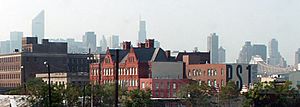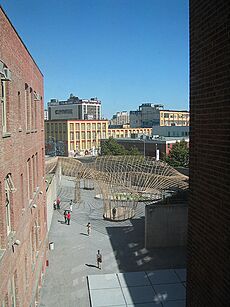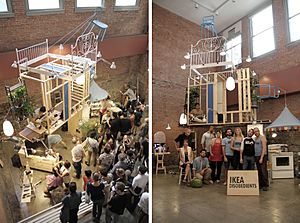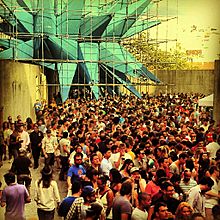MoMA PS1 facts for kids
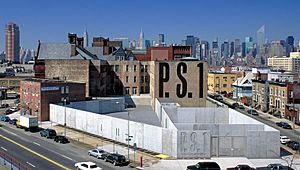
PS1 in 1994, before a major renovation.
|
|
| Established | 1971 |
|---|---|
| Location | 22-01 Jackson Avenue, Long Island City, New York 11101 United States |
| Type | Contemporary art |
| Visitors | Over 200,000 per year |
MoMA PS1 is a famous art space for contemporary art located in the Long Island City neighborhood of Queens, New York. Contemporary art is new art made by artists living today. The museum is in a cool old building that used to be a public school.
Besides showing art, MoMA PS1 is known for its fun events. It hosts the Sunday Sessions performance series and the Warm Up summer music parties. It also runs the Young Architects Program with the famous Museum of Modern Art (MoMA). MoMA PS1 joined with MoMA in 2000, and now more than 200,000 people visit every year.
Contents
History of the Museum
How It All Started
In 1971, a woman named Alanna Heiss had a creative idea. She wanted to turn empty, unused buildings in New York City into places where artists could work and show their art. She started an organization called the Institute for Art and Urban Resources Inc. to make this happen.
Heiss knew that many modern artists were coming to New York. She felt that regular museums didn't have enough space for their unique, large-scale art. These artworks, called site-specific art, are designed for a particular place.
In 1976, she opened the P.S. 1 Contemporary Art Center in an old public school building. The building, which looks like a castle, was built in 1892. It was a school until 1963, but then it was just used as a warehouse. Turning it into an art center gave artists a huge new space to create and exhibit.
In 1997, the museum reopened after a big $8.5 million renovation. The project made the museum even bigger, adding a large outdoor gallery and a new entrance.
Joining with MoMA
In 2000, P.S. 1 officially joined with the Museum of Modern Art (MoMA), one of the most famous art museums in the world. The goal was to work together to help more people enjoy and understand contemporary art.
By teaming up, both museums could share their resources and ideas. They worked together on planning exhibitions, educational programs, and special events. To celebrate their partnership, the museum changed its name to MoMA PS1 in 2010.
Art and Events at MoMA PS1
From the very beginning, MoMA PS1 has been a place for new and experimental art. Its first exhibition in 1976 was called Rooms. For this show, 78 artists created special artworks that fit right into the old classrooms and hallways of the school building.
The museum has shown art by many famous artists from around the world. It also focuses on "outsider artists," who are talented creators without formal art training. Every five years, the museum holds a big show called Greater New York. This exhibition features new and exciting artists who live and work in New York City.
Young Architects Program
The Young Architects Program was a yearly competition for new architects. They were invited to design a temporary structure for MoMA PS1's courtyard. The winning design was built and became the setting for the museum's summer music series, Warm Up. The program was paused in 2019.
Some of the amazing winning designs include:
- 2000: Dunescape by SHoP Architects, which looked like a rolling landscape.
- 2008: Public Farm 1 by WorkAC, which was a working urban farm.
- 2012: Wendy by HWKN, a giant blue spiky sculpture that cleaned the air.
- 2014: Hy-Fi by The Living, a tower made of special bricks grown from corn stalks and mushrooms.
Warm Up Summer Music Series
Warm Up is MoMA PS1's popular outdoor music event that takes place every summer. It started in 1997 as a way to bring more people to the museum. The parties happen on Saturdays in the museum's courtyard, inside the cool structure built by the winner of the Young Architects Program.
The series features famous DJs and live bands from all over the world. It's a huge party where thousands of people come to dance, see art, and have fun. Some of the many musicians who have performed include Solange, Jamie XX, Grimes, and Lizzo.
Long-Term Art Installations
MoMA PS1 has several artworks that are always on display. These pieces are a permanent part of the building.
Some of the long-term installations you can see are:
- James Turrell, Meeting (1986): A special room on the third floor with an opening in the ceiling. At sunset, you can watch the sky change colors in a beautiful and peaceful way.
- Pipilotti Rist, Selbstlos im Lavabad (Selfless in the Bath of Lava) (1994): A tiny video screen hidden in a small hole in the lobby floor. If you look closely, you can see the artist waving from inside a volcano.
- Sol LeWitt, Crayola Square (1999): A colorful drawing made with crayons directly on a wall in the basement.
- Saul Melman, Central Governor (2010): The artist covered the building's old boiler and pipes in the basement with gold leaf, turning the machinery into a sculpture.
See also
 In Spanish: MoMA PS1 para niños
In Spanish: MoMA PS1 para niños


